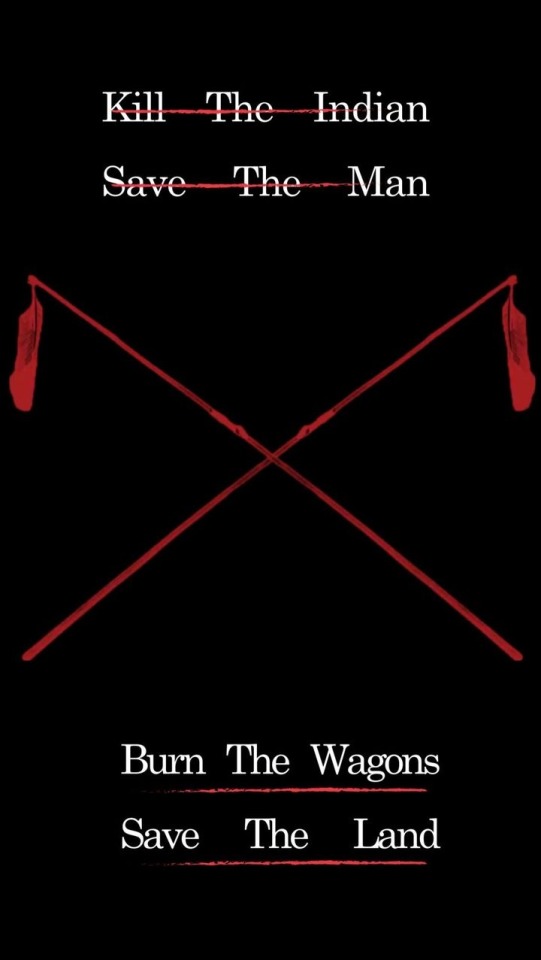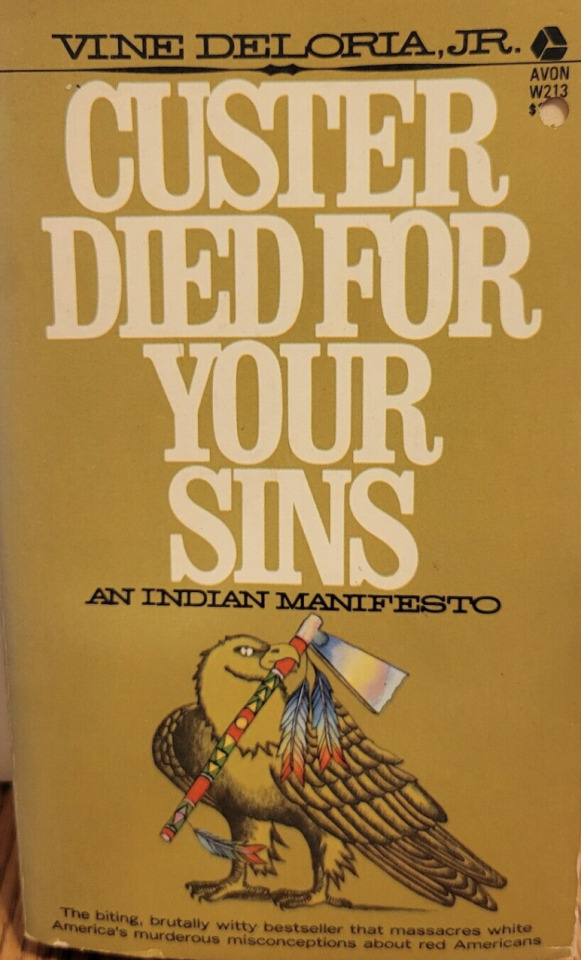#Custer died for your sins
Text

172 notes
·
View notes
Text
Often when discussing treaty rights with whites, Indians find themselves being told that “We gave you the land and you haven’t done anything with it.” Or some commentator, opposed to the welfare state remarks, “We gave the Indians a small piece of land and then put them on the dole and they are unable to take care of themselves.”
The truth is that practically the only thing the white men ever gave the Indian was disease and poverty. To imply that Indians were given land is to completely reverse the facts of history.
- Custer Died For Your Sins by Vine Deloria Jr.
#book quote#custer died for your sins#vine deloria jr#nonfiction#history#politics#quote#quotes#booklr#bookblr
574 notes
·
View notes
Text

I've waited 2 months for this to be available
The book was noteworthy for its relevance to the Alcatraz-Red Power Movement and other activist organizations, such as the American Indian Movement, which was beginning to expand. Deloria's book encouraged better use of federal funds aimed at helping Native Americans. Vine Deloria, Jr. presents Native Americans in a humorous light, devoting an entire chapter to Native American humor. Custer Died for Your Sins was significant in its presentation of Native Americans as a people who were able to retain their tribal society and morality, while existing in the modern world.
From wiki
The book description:
"In his new preface to this paperback edition, the author observes, "The Indian world has changed so substantially since the first publication of this book that some things contained in it seem new again." Indeed, it seems that each generation of whites and Indians will have to read and reread Vine Deloria’s Manifesto for some time to come, before we absorb his special, ironic Indian point of view and what he tells us, with a great deal of humor, about U.S. race relations, federal bureaucracies, Christian churches, and social scientists. This book continues to be required reading for all Americans, whatever their special interest."
#vine deloria jr#custer died for your sins#indigenous activists#us history#native history#american history#indigenous liberation#native liberation#native books#indigenous books#american indian movement#Alcatraz Red Power movement#decolonize#decolonization
18 notes
·
View notes
Text

From @JoeCrowShoe
#burn the wagons#save the land#land defender#water defender#landback#aim#crazy horse#Tasunke Witco#greasy grass#little big horn#Custer died for your sins#tecumseh#zapata#Geronimo#john trudell#Leonard Peltier#free Leonard Peltier#climate change#ohlone territory
30 notes
·
View notes
Text
having old archaeologists as professors is pretty cool. sometimes they'll just go on a rant and talk about how they met so-and-so famous archaeologist during some conference in the stone age and how some white feminist cultural anthropologist got pissed at a radical sioux archaeologist for calling them a bunch of racist dicks
#margaret mead#vine deloria#custer died for your sins#god is red#archaeology#anthropology#indigenous archaeology
7 notes
·
View notes
Text
“The largest difference I can see between Indian religion and Christian religions is in inter-personal relationships. Indian society had a religion that taught respect for all members of society.
Remember, Indians had a religion that produced a society in which there were no locks on doors, no orphanages, no need for oaths, and no hungry people. Indian religion taught that sharing one's goods with another human being was the highest form of behavior. The Indian people have tenaciously held to this tradition of sharing their goods with other people in spite of all attempts by churches, government agencies, and schools to break them of the custom.
Christianity came along and tried to substitute "giving" for sharing. There was only one catch: giving meant giving to the church, not to other people. Giving, in the modern Christian sense, is simply a method of shearing the sheep, not of tending them."
- Vine Deloria, Jr.
From the book: "Custer Died For Your Sins"
33 notes
·
View notes
Text
[Doctrine of] Discovery negated the rights of the Indian tribes to sovereignty and equality among the nations of the world. It took away their title to their land and gave them the right only to sell. And they had to sell it to the European nation that had discovered their land.
Vine Deloria Jr. (Standing Rock Sioux), Custer Died for Your Sins: An Indian Manifesto, first published in 1969
#vine deloria jr#kashoplili#quotes#native american#indigenous#doctrine of discovery#ok last one for now
67 notes
·
View notes
Note
Do you have any books rec on colonialism or, antropology?
Clearing the Plains: Disease, Politics of Starvation, and the Loss of Aboriginal Life by James Daschuk
Orientalism by Edward W. Said
The Inconvenient Indian by Thomas King
Bury My Heart at Wounded Knee by Dee Brown
Custer Died For Your Sins: An Indian Manifesto by Vine Deloria Jr
They Were Her Property: White Women as Slave Owners in the American South by Stephanie E. Jones-Rogers
145 notes
·
View notes
Photo


In 1855, white militias received five dollars for every severed Native American head they brought to authorities in Shasta, California.
In 1863, white militias were paid twenty-five cents per Indigenous scalp in Honey Lake, California.
Colonel John Chivington of the US Army said in 1864, “Damn any man who sympathizes with Indians … I have come to kill Indians, and believe it is right and honorable to use any means under God’s heaven to kill Indians. … Kill and scalp all, big and little.”
The Yreke Herald published an editorial on August 7, 1853: “Extermination is no longer a question of time – the work has commenced and let the first man that says treaty or peace be regarded as a traitor.”
One hundred thousand Native Americans were killed during the first two years of the California gold rush. It was a period that historian Alvin Josephy called “as close to genocide as any tribal people had faced, or would face, on the North American continent.”
Peter Burnett, the first Governor of California, said during his January 1851 address, that “a war of extermination will continue to be waged between the two races until the Indian race becomes extinct [and] the inevitable destiny of the race is beyond the power or wisdom of man to avert.”
As the author Vine Deloria Jr. wrote in Custer Died For Your Sins, the prevailing attitude was “that Indians were wild animals to be hunted and skinned. Bounties were set and an Indian scalp became more valuable than beaver, otter, marten, and other animal pelts.”
37 notes
·
View notes
Text

Introduction
Recommended Reading
Errico Malatesta, At the Cafe: Conversations on Anarchism. London: Freedom Press, 2005.
The Dark Star Collective, Quiet Rumours: An Anarcha-Feminist Reader. Oakland: AK Press, 2002.
CrimethInc., Days of War, Nights of Love. CrimethInc. 2002.
Daniel Guerin, Anarchism: From Theory to Practice. New York: Monthly Review, 1996.
bell hooks, Ain’t I a Woman? Black women and feminism. Boston: South End Press, 1981.
Mitchell Verter and Chaz Bufe, eds. Dreams of Freedom: A Ricardo Flores Magon Reader. Oakland: AK Press, 2005.
Derrick Jensen, A Culture of Make Believe. White River Junction, Vermont: Chelsea Green, 2004.
Vine Deloria, Jr. Custer Died for Your Sins: an Indian Manifesto. New York: Macmillan, 1969.
Ward Churchill, From a Native Son: Selected Essays on Indigenism 1985–1995, Cambridge: South End Press, 1999; or his interview on Indigenism and Anarchism in the journal Upping the Anti.
#anarchism#daily posts#communism#anti capitalist#anti capitalism#late stage capitalism#anarchy#anarchists#libraries#leftism#recommended reading
6 notes
·
View notes
Text
Vine Deloria Jr.’s “Custer Died for Your Sins: An Indian Manifesto”
❍❍❍

This is a classic read for anyone interested to understand the treaty relationship between the United States/Canadian governments and indigenous peoples along with the history of lies and false promises made by the European colonizers stealing indigenous land. The writer also goes into detail about recent history (before the 1970s) and the political achievements of indigenous peoples to regain and maintain their special status and sovereignty of their land. He also dives into cultural stereotypes and the history of white/red relationships in daily life. He makes fun of two unique species of homo-sapiens called: anthropologists and Christian missionaries.
Second to Roxanne Dunbar-Ortiz’s "An Indigenous Peoples' History of the United States" and George Manuel’s “The Fourth World: An Indian Reality" this was one of the most helpful books I have read on North American indigenous context and their struggle against European invasion. One of the most powerful things that he mentions in the book is the notion of freedom, between the Europeans and indigenous peoples: indigenous people in North America, similar to colonized nations in Global South, see "nationalism" (as well as "Tribalism") as a positive aspect of indigenous-ness against settler colonialism.
15 notes
·
View notes
Text
The complicity of the churches too is just beginning to be recognized. After several hundred years of behind-the-scenes machinations, the attempt of the churches to appear relevant to the social needs of the 1960’s is regarded as utter hypocrisy by many Indian people. If, they argue, the churches actually wanted justice, why haven’t they said or done anything about Indian rights? Why do they continue to appear in bib-overalls at the Poor People’s March? Why do they wait until a problem is nearly solved and then piously proclaim from the pulpits that they have discovered that the movement is really God’s will?
Custer Died For Your Sins by Vine Deloria Jr.
#book quote#custer died for your sins#vine deloria jr#nonfiction#history#politics#quote#quotes#booklr#bookblr
2 notes
·
View notes
Text
Haunted States of America: South Dakota

Ghostly Tales of the Black Hills and Badlands (2000) by Ruth D. Hein
The Black Hills mountain range and Badlands are located in southwest South Dakota and are home to a variety of national parks. A large part of the book features the Bullock Hotel in Deadwood, South Dakota and recounts stories of its original owner, Seth Bullock, who appears as a sometimes helpful, sometimes playful ghost haunting his building.
Because of the history of land seizures and broken treaties in the Black Hills and Badlands region by the American government against the Lakota people, we suggest you take a look at these books from our collection:
Disinherited: The Lost Birthright of the American Indian (1967) by Dale Van Every
Custer Died for Your Sins: An Indian Manifesto (1970) by Vine Deloria, Jr.
Bury My Heart at Wounded Knee: An Indian History of the American West (1971) by Dee Brown
The Browne Popular Culture Library (BPCL), founded in 1969, is the most comprehensive archive of its kind in the United States. Our focus and mission is to acquire and preserve research materials on American Popular Culture (post 1876) for curricular and research use. Visit our website at https://www.bgsu.edu/library/pcl.html.
#bgsu#libraries on tumblr#haunted states of america#books#ghosts#south dakota#black hills#badlands national park#native americans
2 notes
·
View notes
Text

Taos, NM had the coolest t-shirt shop. I miss that place.
Goyaałé, or Geronimo, waged asymmetrical warfare against the Mexican and US governments for 20-30 years. He finally surrendered near Fort Bowie AZ in 1886.
#fighting terrorism since 1492#fighting illegal immigration since 1492#land back#free Leonard Peltier#Geronimo#Goyaałé#land defender#water protector#new mexico#land of enchantment#rio grande#taos#anti fascist#leonard peltier#crazy horse#Custer died for your sins
2 notes
·
View notes
Text

Book read in 2022
Some gaps with busy schedules in my second and third years of medical school, but still managed to read some great books. Separate list with audiobooks (it got wayyy too long.)
January
The Wretched of the Earth by Frantz Fanon
Notebook of a Return to the Native Land by Aime Cesaire
February
March
Red Skin, White Masks: Rejecting the Colonial Politics of Recognition by Glen Sean Coulthard
The Jakarta Method: Washington's Anticommunist Crusade and the Mass Murder Program that Shaped Our World by Vincent Bevins
April
The Mismeasure of Man by Stephen Jay Gould
A People's History of the United States by Howard Zinn
May
June
The Devil's Chessboard: Allen Dulles, the CIA, and the Rise of America's Secret Government by David Talbot
How to Blow Up a Pipeline by Andreas Malm
Akira, Vol. 1 by Katsuhiro Otomo
July
My Year of Rest and Relaxation by Ottessa Moshfegh
Akira, Vol. 2 by Katsuhiro Otomo
My Heart is a Chainsaw by Stephen Graham Jones
A Court of Thorns and Roses by Sarah J Maas
Akira, Vol. 3 by Katsuhiro Otomo
If I Had Your Face by Frances Cha
Orlando by Virginia Woolf
Norwegian Wood by Haruki Murakami
Death in Her Hands by Ottessa Moshfegh
Chouette by Claire Oshetsky
Matrix by Lauren Groff
If We Were Villians by M.L. Rio
August
Disorientation by Elaine Hsieh Chou
A Certain Hunger by Chelsea Summers
Fates and Furies by Lauren Groff
McGlue by Ottessa Moshfegh
Custer Died for Your Sins: An Indian Manifesto by Vine Deloria, Jr.
Milk Fed by Melissa Broder
After Dark by Haruki Murakami
Cult Classic by Sloane Crossley
Lapvona by Ottessa Moshfegh
September
Akira, Vol. 5 by Katsuhiro Otomo
Little Eyes by Samanta Schweblin
Eileen by Ottessa Moshfegh
The Metamorphosis by Franz Kafka
Kafka on the Shore by Haruki Murakami
October
The Vegetarian by Kang Han
NSFW by Isabel Kaplan
The New Me by Halle Butler
November
December
Acts of Service by Lillian Fishman
Small Game by Blair Braverman
These Violent Delights by Micah Nemerever
Homesick for Another World by Ottessa Moshfegh
Tender is the Flesh by Agustina Bazterrica
Interview with the Vampire by Anne Rice
Sex & Rage: Advice to Young Ladies Eager for a Good Time by Eve Babitz
The Lottery and Other Stories by Shirley Jackson
We Have Always Lived in the Castle by Shirley Jackson
Key: strikethrough = DNF; bold = loved
#apologies for such a long list#book list#book blog#bookblr#book recommendations#fiction#nonfiction#ottessa moshfegh#haruki murakami#books and reading#year in books#reading#med student
4 notes
·
View notes
Quote
It is time for both black and red to understand the ways of the white man. The white is after Indian lands and resources. He always has been and always will be...The problem is and always has been the adjustment of the legal relationship between the Indian tribes and the federal government, between the true owners of the land and the usurpers...The problem, therefore, is not one of legal status, it is one of culture and social and economic mobility...A socio-economic, rather than legal adjustment must consequently be the goal...
But the understanding of the racial question does not ultimately involve understanding by either blacks or Indians. It involves the white man himself. He must examine his past. He must face the problems he has created within himself and within others. The white man must no longer project his fears and insecurities onto other groups, races, and countries. Before the white man can relate to others he must forego the pleasure of defining them. The white man must learn to stop viewing history as a plot against himself.
Vine Deloria Jr., “Custer Died For Your Sins: An Indian Manifesto,” Chapter 8, page 191
I wish this had made it into the zine, but it’s taken me a while to get through this book; my brain doesn’t always do well with legal stuff, so I switched to the audiobook version halfway through and it’s been going better. In this chapter, Deloria Jr then proceeds to summarize the entire backlog of white trauma that fuels the perpetuation of violence against other group in a passage that, much like the rest of this book, is straight fire.
2 notes
·
View notes